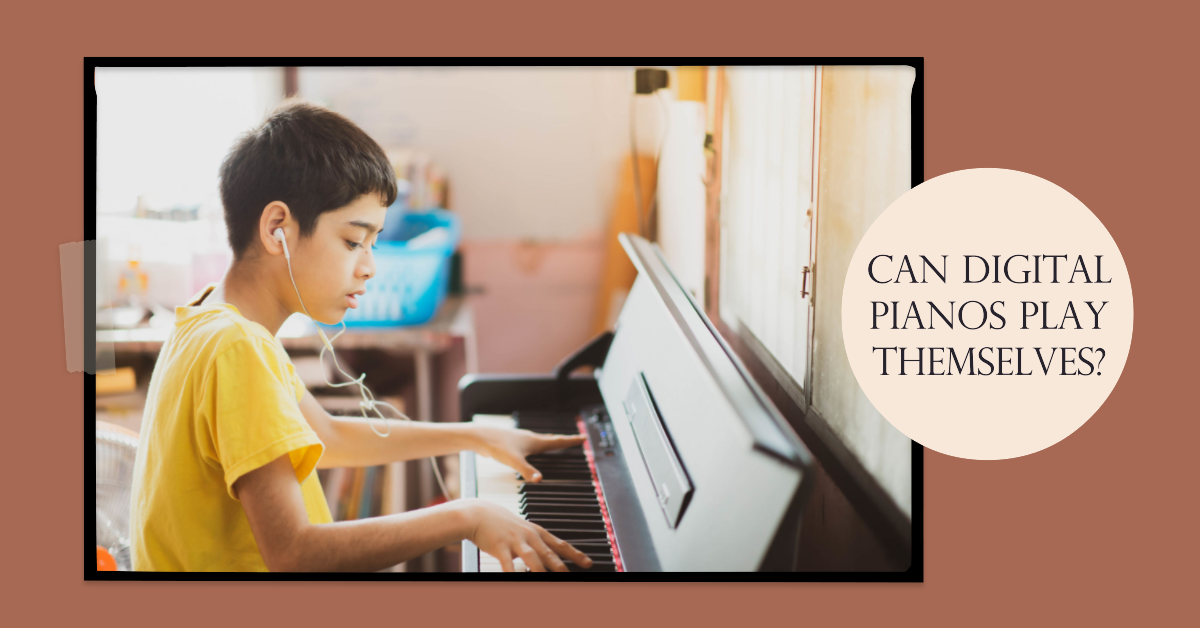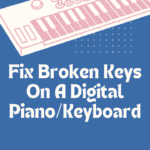Digital pianos have revolutionized the way people play and enjoy music. These instruments offer a wide range of features that are not available in traditional acoustic pianos.
They allow musicians to adjust the volume, change the sound, and even record their performances. One of the most fascinating features of digital pianos is their ability to play themselves.
In this article, we will explore the technology behind self-playing digital pianos, their benefits and limitations, as well as examples of these instruments in action. We will also discuss the future potential for these instruments as advancements in technology continue to evolve.
Explanation of Digital Pianos
A digital piano is an electronic keyboard that uses digital signals to produce sound. The instrument is designed to mimic the sound and feel of an acoustic piano while offering additional features such as headphone jacks for quiet practice, MIDI connectivity for recording purposes or connecting with other musical devices or speakers. Unlike acoustic pianos that require regular tuning to maintain their sound quality, a digital piano’s sound remains consistent over time without any need for maintenance or adjustment.
Most digital pianos come with weighted keys similar to those on an acoustic piano that provide varying resistance depending on how hard they are pressed down. This creates a more realistic playing experience than non-weighted keyboards or synthesizers which do not replicate this feature.
Brief History of Self-Playing Instruments
Self-playing instruments have been around since the late 19th century when automatic music boxes were invented by Swiss watchmakers. These musical machines used punched paper rolls to play pre-programmed music without human intervention. Later advancements included player pianos that used perforated paper rolls with holes arranged in specific patterns that triggered pneumatic valves inside the instrument’s casing when played back through a mechanism attached to its keyboard.
These instruments became popular in the early 20th century and were often used in saloons, dance halls and home entertainment. They remained popular until the advent of radio and recorded music which eventually overtook their popularity.
Overview of the Topic: Can Digital Pianos Play Themselves?
One of the most intriguing features of digital pianos is their ability to play themselves. This capability is achieved through the use of MIDI (Musical Instrument Digital Interface) technology.
MIDI files contain data that can be read by digital pianos, instructing them on how to play a particular piece of music automatically. This feature has become increasingly popular among musicians and enthusiasts who wish to enjoy live performances without having to physically play themselves or as accompaniment for other instruments.
The Technology Behind Self-Playing Digital Pianos
MIDI technology and its role in self-playing pianos
MIDI stands for Musical Instrument Digital Interface. It is a protocol that allows electronic musical instruments, computers, and other devices to communicate with each other.
MIDI files contain information about how music should be played, including notes, tempo, dynamics, and more. Digital pianos use MIDI technology to play back pre-recorded performances.
When a MIDI file is loaded into a digital piano that supports self-playing features, the instrument reads the file and translates it into sound using its internal sound engine. This allows the piano to play back the performance exactly as it was recorded.
How MIDI files work with digital pianos to create a self-playing experience
MIDI files can be created using software or recorded from live performances using specialized equipment. Once a MIDI file is created, it can be loaded onto a digital piano that supports self-playing features. When a MIDI file is played on a digital piano with self-playing capabilities, the instrument reads the data in the file and converts it into sound using its internal sound engine.
This allows the piano to play back the performance exactly as it was recorded. Some digital pianos also allow users to customize their own performances by recording their playing as a MIDI file and then playing it back on the instrument later.
Advancements in technology that have made self-playing digital pianos more advanced
Advancements in technology have led to improvements in both the quality of sound produced by digital pianos and the accuracy of their self-playing features. Modern digital pianos use advanced sampling techniques to capture realistic acoustic piano sounds.
These samples are then stored in memory banks within the instrument so they can be accessed quickly when needed. Additionally, modern digital pianos feature more advanced processing power that allows them to handle complex MIDI files with ease.
This means that self-playing pianos are now capable of playing back more complex and nuanced performances than ever before. Overall, the technology behind self-playing digital pianos has come a long way in recent years, allowing for more realistic and dynamic performances to be created and enjoyed.
The Benefits of Self-Playing Digital Pianos
Convenience for Musicians and Music Enthusiasts
One significant benefit of self-playing digital pianos is the convenience they offer. Musicians and music enthusiasts alike can enjoy high-quality music without being present at all times. For those with busy schedules, this feature is incredibly useful because it eliminates the need for them to practice or perform themselves.
Additionally, self-playing digital pianos can be used in a variety of settings such as homes, studios, or venues. This versatility means that users can have access to music whenever and wherever they want it.
Ability to Learn from Pre-Recorded Performances
Another significant benefit of self-playing digital pianos is that they offer a unique opportunity for musicians to learn from pre-recorded performances. By listening carefully to these performances, musicians can improve their technique, timing, and musicality.
Furthermore, some self-playing digital pianos come with built-in lessons and tutorials that help users learn how to play specific pieces. These lessons are particularly helpful for beginners who are just starting on their musical journey.
Enhanced Entertainment Value for Events and Venues
Self-playing digital pianos also provide enhanced entertainment value for events and venues. With these instruments, event organizers can create a unique ambience that sets the tone for the occasion.
For example, a restaurant owner may use a self-playing piano as background music during dinner service. Similarly, an event planner may use one at a wedding reception or corporate event as part of the entertainment lineup.
Overall, the benefits of self-playing digital pianos are numerous. Whether you’re a musician looking to improve your skills or an event organizer seeking high-quality entertainment options – there’s something in it for everyone!
Limitations and Drawbacks of Self-Playing Digital Pianos
Limited Repertoire Compared to Live Performances
One of the primary limitations of self-playing digital pianos is their limited repertoire. While many models come pre-loaded with numerous songs and MIDI files, they are still no match for a skilled live performer who can play a vast range of music genres and styles. Additionally, the available repertoire for self-playing digital pianos may not match everyone’s musical tastes, meaning the user may be limited in terms of listening enjoyment.
Lack of Personal Touch and Emotion in the Performance
Another significant drawback of self-playing digital pianos is that they lack the personal touch and emotion that live performers bring to their performances. When listening to a live performance, listeners can feel more connected to the music due to the interpretation and expression brought by the musician’s unique style. Self-playing digital pianos cannot replicate this level of personal connection between musician and listener.
Moreover, even slight variations in tempo or timing during a live performance add an element of unpredictability that can make it more exciting for listeners. In contrast, self-playing digital pianos often follow pre-programmed tracks precisely without any deviation from what is predetermined.
Potential Technical Difficulties with the Instrument or MIDI Files
Like any technological device, self-playing digital pianos are not immune to technical difficulties or malfunctions. Issues with MIDI files such as corrupted files or incorrect data encoding can cause errors in playback or render certain features unusable. Furthermore, hardware issues such as malfunctioning sensors or keys can also affect performance.
While some models offer built-in diagnostics systems to detect potential technical issues early on before they escalate into severe problems, others may require manual intervention from a technician if something goes wrong. While self-playing digital pianos have many benefits and are a convenient option for anyone looking to enjoy music, there are also some drawbacks to consider.
Even with technological advancements, they cannot fully replicate the personal touch and emotional connection that live performers bring to their performances, nor can they match the vast repertoire of genres and styles that experienced musicians can offer. Additionally, like any technological device, potential technical difficulties or even hardware problems can pose challenges for users.
Examples of Self-Playing Digital Pianos in Action
Digital pianos with self-playing features have become increasingly popular in recent years, particularly for entertainment purposes in various venues. Here are some examples of self-playing digital pianos in action:
Popular Brands That Offer Self-Playing Features on Their Instruments
One of the most well-known brands that offer self-playing features on their digital pianos is Yamaha. Their Disklavier series includes models with built-in MIDI technology that can play pre-recorded performances. These instruments can also record and play back performances, making them popular for musicians who want to review and improve their playing.
Roland is another brand that offers self-playing features on their digital pianos. The company’s Piano Partner 2 app allows users to connect their Roland piano to a mobile device and access a range of interactive features, including the ability to play along with pre-recorded songs.
Kawai is another brand that offers self-playing features on some of its digital pianos. The company’s AnytimeX hybrid piano comes equipped with a player system that can play music from USB drives or streaming services.
Venues and Events That Utilize Self-Playing Digital Pianos for Entertainment Purposes
Self-playing digital pianos have become increasingly popular in various venues and events, including restaurants, hotels, and weddings. Many establishments use these instruments as a way to provide background music without having to hire live musicians.
One example of an event that utilizes self-playing digital pianos is the annual West Coast Ragtime Festival. The festival includes performances from live musicians as well as self-playing instruments, which allow attendees to experience a range of different styles and genres.
In addition, many theatre productions use self-playing digital pianos as part of their orchestration. For instance, the London production of Phantom of the Opera used a Yamaha Disklavier piano to accompany the show.
Overall, self-playing digital pianos have become a popular choice for musicians and entertainment venues alike. With their versatility and convenience, they offer a unique way to experience music in a range of different settings.
Conclusion: The Future of Self-Playing Digital Pianos
The Potential for Advancements in Technology
Digital pianos with self-playing features have come a long way since their inception, and there is still much potential for advancements in technology. Already, some digital pianos can analyze a live performance and generate a MIDI file that can be played back on the instrument as if the performer were playing it themselves. In the future, we may see even more sophisticated systems that can adapt to different playing styles or even learn from and emulate specific performers.
The Future of Live Performances
It’s important to note that while self-playing digital pianos have their benefits, they will never replace live performances completely. Many people value the unique emotional connection between a live performer and an audience, as well as the spontaneity and improvisation that comes with a live performance. However, self-playing digital pianos may become increasingly popular in venues where it’s not feasible or cost-effective to hire a live musician.
The Impact on Music Education
Self-playing digital pianos also have significant potential in music education. By providing high-quality pre-recorded performances for students to study and learn from, these instruments could help make music education more accessible and engaging for students of all ages. Additionally, as technology continues to improve, we may see self-playing features integrated into educational software and online platforms that allow students to practice alongside pre-recorded performances.
While there are some limitations and drawbacks associated with self-playing digital pianos, they offer many benefits as well – from convenience for musicians to enhanced entertainment value at events. As technology continues to improve, we can expect these instruments to become even more sophisticated and capable of generating nuanced performances that rival those of live musicians.





